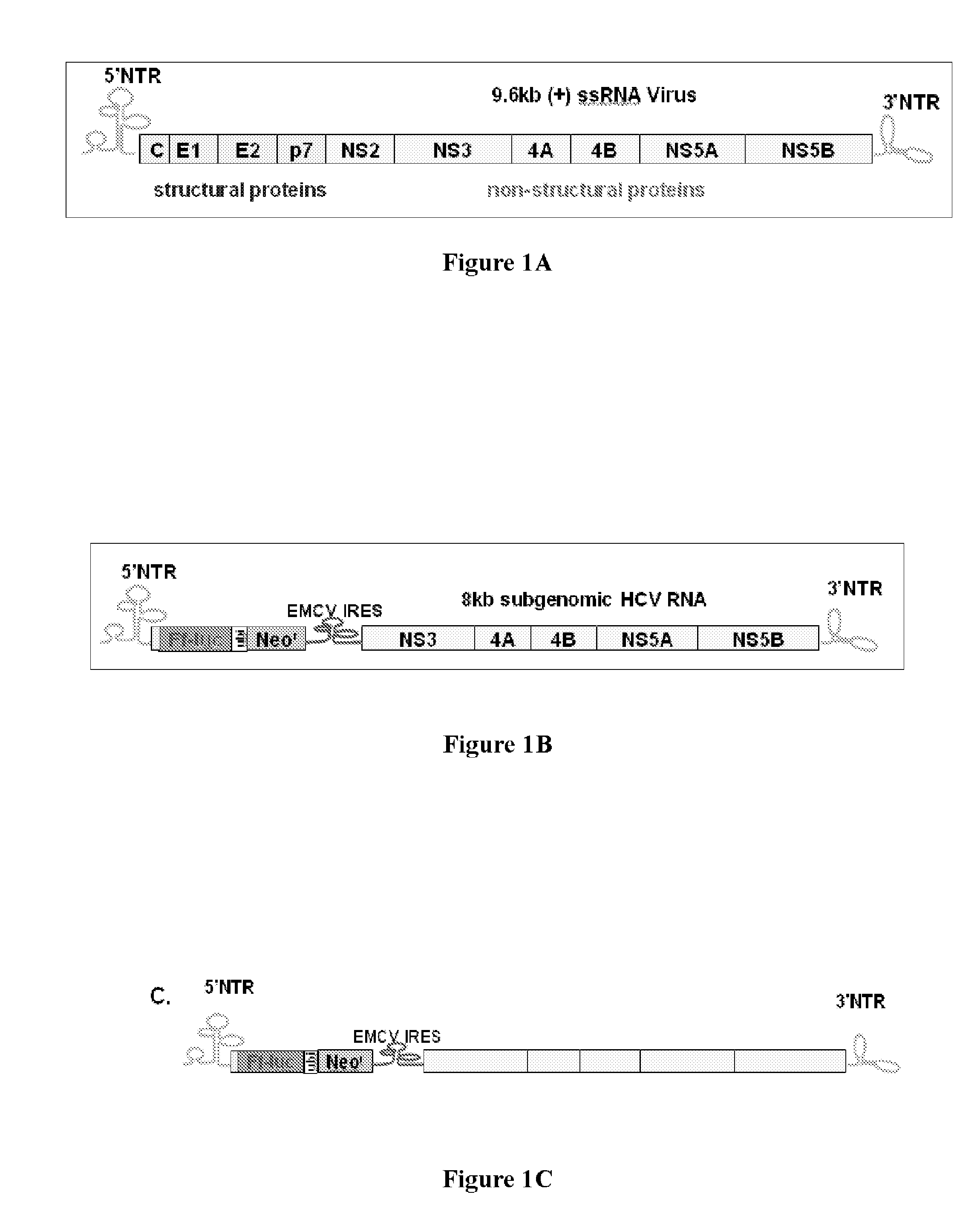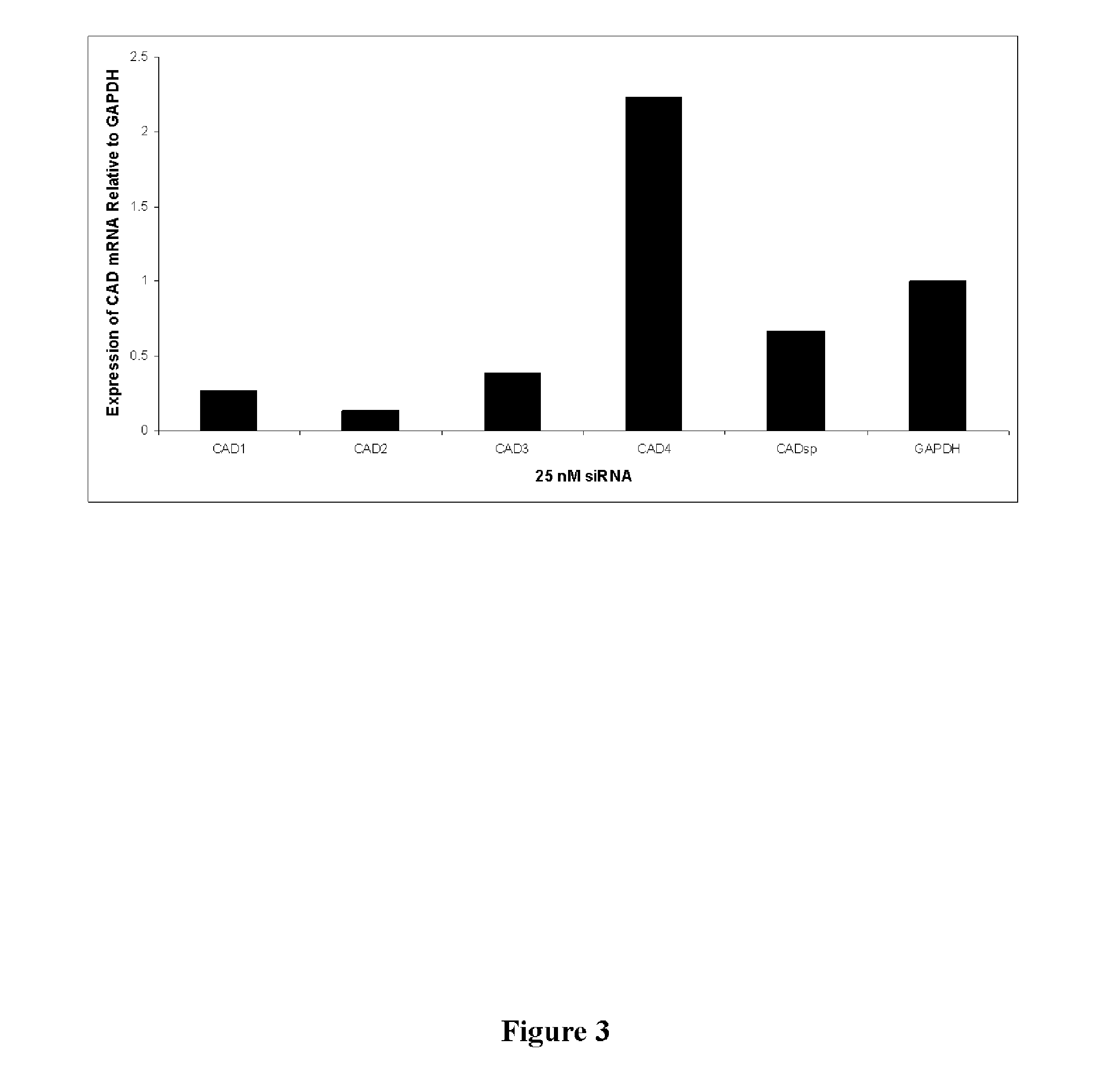dsRNA FOR TREATING VIRAL INFECTION
a technology of dsrna and viral infection, applied in the field of dsrna for treating viral infection, can solve the problems of millions of deaths, debilitating disease and/or morbidity, virus inability to survive, etc., and achieve the effect of reducing the level or activity of human host factor
- Summary
- Abstract
- Description
- Claims
- Application Information
AI Technical Summary
Benefits of technology
Problems solved by technology
Method used
Image
Examples
example 1
dsRNA Synthesis
[0114]Source of Reagents
[0115]Where the source of a reagent is not specifically given herein, such reagent may be obtained from any supplier of reagents for molecular biology at a quality / purity standard for application in molecular biology.
[0116]siRNA Synthesis
[0117]Single-stranded RNAs were produced by solid phase synthesis on a scale of 1 μmole using an Expedite 8909 synthesizer (Applied Biosystems, Applera Deutschland GmbH, Darmstadt, Germany) and controlled pore glass (CPG, 500 Å, Proligo Biochemie GmbH, Hamburg, Germany) as solid support. RNA and RNA containing 2′-O-methyl nucleotides were generated by solid phase synthesis employing the corresponding phosphoramidites and 2′-O-methyl phosphoramidites, respectively (Proligo Biochemie GmbH, Hamburg, Germany). These building blocks were incorporated at selected sites within the sequence of the oligoribonucleotide chain using standard nucleoside phosphoramidite chemistry such as described in Current protocols in nuc...
example 2
dsRNA Expression Vectors
[0139]In another aspect of the invention, dsRNA molecules that modulate CAD expression activity are expressed from transcription units inserted into DNA or RNA vectors (see, e.g., Couture, A, et al., TIG. (1996), 12:5-10; Skillern, A., et al., International PCT Publication No. WO 00 / 22113, Conrad, International PCT Publication No. WO 00 / 22114, and Conrad, U.S. Pat. No. 6,054,299). These transgenes can be introduced as a linear construct, a circular plasmid, or a viral vector, which can be incorporated and inherited as a transgene integrated into the host genome. The transgene can also be constructed to permit it to be inherited as an extrachromosomal plasmid (Gassmann, et al., Proc. Natl. Acad. Sci. USA (1995) 92:1292).
[0140]The individual strands of a dsRNA can be transcribed by promoters on two separate expression vectors and co-transfected into a target cell. Alternatively each individual strand of the dsRNA can be transcribed by promoters both of which ar...
example 3
Identification of CAD as Essential Host Targets for HCV Infection
[0147]A large scale transfection based siRNA delivery system was used to identify the CAD target. This system was described previously (Borawski J, Lindeman A, Buxton F, Labow M, Gaither L A. Optimization procedure for small interfering RNA transfection in a 384-well format. J Biomol Screen. 2007 June; 12 (4): 546-59. Epub 2007 April 13), incorporated herein by reference.
[0148]In the instant case, the system employed an HCV subgenomic replicon system designed to identify host proteins essential for HCV replication. A Huh7 subgenomic replicon cell line (as described by Lohmann, V., et. al. (1999) Science. 285:110) was screened using a kinome (i.e. the known kinases of the human genome (Dharmacon (Boulder Colo.)) siRNA library. The HCV subgenomic replicon system allows for HCV replication to be studied in vitro and in vivo using human hepatoma cells (Huh7) stably transformed with the modified HCV genome lacking the struc...
PUM
| Property | Measurement | Unit |
|---|---|---|
| Fraction | aaaaa | aaaaa |
| Fraction | aaaaa | aaaaa |
| Molar density | aaaaa | aaaaa |
Abstract
Description
Claims
Application Information
 Login to View More
Login to View More - R&D
- Intellectual Property
- Life Sciences
- Materials
- Tech Scout
- Unparalleled Data Quality
- Higher Quality Content
- 60% Fewer Hallucinations
Browse by: Latest US Patents, China's latest patents, Technical Efficacy Thesaurus, Application Domain, Technology Topic, Popular Technical Reports.
© 2025 PatSnap. All rights reserved.Legal|Privacy policy|Modern Slavery Act Transparency Statement|Sitemap|About US| Contact US: help@patsnap.com



